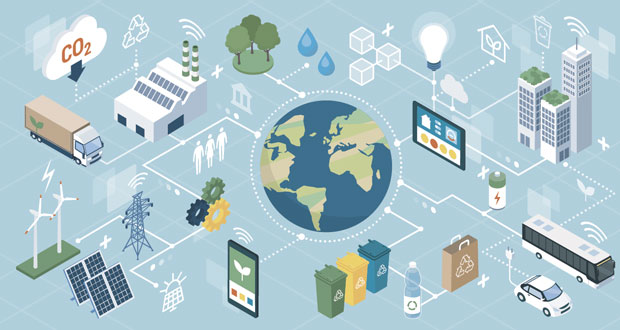Given the urgent need for the world to address global warming, a group of technology specialists explain how CAFM can help FMs tackle climate change
In anticipation of the COP26 summit taking place this November in Glasgow organisations are gearing up to meet obligations to achieve net zero emissions. For years CAFM systems have helped FMs manage the performance of assets and now the technology is being primed to respond to growing requirements to help FMs meet sustainability objectives. We asked some of the leading CAFM developers for insights into the range of solutions on offer.
 Peter Tyler, Director of Technology for FSI, along with Damian Moore, Senior Business Analyst and Louise Gregory, Business Development Manager team.
Peter Tyler, Director of Technology for FSI, along with Damian Moore, Senior Business Analyst and Louise Gregory, Business Development Manager team.
At the inception of the facilities management industry, there were FM teams holed up in basements and wall-to-wall filing cabinets filled with papers documenting jobs. With CAFM now widely adopted, teams have thankfully shaken off these outdated processes, digitised the way they collect data and ditched unnecessary printouts wreaking havoc on the environment (and the sanity of those trying to locate information). But saving tons of paper only scratches the surface of what CAFM continues to achieve.
REDUCING EMISSIONS
Up until a few years ago, many engineers still needed to drive back and forth to collect and drop off job sheets and to pick up items of stock or parts. Now, through the power of CAFM and dedicated workforce apps, they are able to access asset data from their devices anywhere, receive briefs on-the-go and know exactly when and where they are needed as well as what they need to complete the work.
Resource planning modules allow to-the-minute scheduling, with engineers assigned based on task priorities and factual data such as their exact location. This greatly reduces unnecessary journeys and eliminates the issuing of manual worksheets. Additionally, the slow but certain uptake of IOT sensor technology is helping to reduce unnecessary travel even further.
EMBRACING IOT
By installing sensors across different assets and applications, more informed data can be collected about when an engineer needs to be on-site, but also exactly what they will be doing whilst on site.
Let’s take the small but essential event of Legionella control as an example. Regular monitoring and flushing of taps and toilets helps keep Legionella at bay. But what IOT sensor technology can do is monitor exactly when the system needs flushing, preventing unneeded trips and reducing water wastage.
IOT brings a whole new dimension to CAFM, connecting data and assets closer than ever before. Think smarter buildings, reduced electricity waste, issues identified before they impact the building, and ultimately minimal energy usage and costs.
DATA IS ENCOURAGING ACCOUNTABILITY
CAFM gives teams accurate data in realtime and allows them to make more educated decisions because of this. Monitoring energy consumption, compliance obligations and the wider asset network gives management complete accountability and ownership over what’s happening inside a building. Intuitive BI dashboards and dedicated contractor apps give teams total visibility of their portfolio’s compliance obligations, energy usage, and much more.
They can control air quality, track CO2 levels, humidity and room temperatures to ensure optimal comfort levels and prevent unnecessary energy waste, such as the automatic opening of windows, or outside air dampers to circulate more fresh air. Systems themselves can be monitored and regular maintenance checks can be booked automatically based on usage. Considered maintenance task scheduling helps improve asset lifecycles and reduces the need to replace units unnecessarily.
Having this data at your fingertips allows decisions about energy usage to be made and prevents lots of in-person checking, tweaking and maintenance from needing to happen.
POWER OF THE BMS
Many clients are waking up to the power of the data that their Building Management System holds. We can save a lot of energy simply by monitoring the BMS and building controls themselves. For example, if we identify that an air handling unit is expending a lot of heat in one area but less so in others, wireless IoT sensors can then be used at a very granular level to troubleshoot these problematic areas to indicate exactly where thermal loss is occurring. Alone, a BMS would not be able to pick up on this issue, but they can provide the initial insight that informs the wider FM strategy.
Quite simply, just knowing when equipment is running, at what rate and for how long can provide important clues as to where energy is consumed unnecessarily.
CUSTOMER EXPERIENCE AND ENERGY SAVINGS
Whether it’s identifying a leak or optimising temperatures, CAFM aims to help teams reduce their environmental impact without compromising on customer experience – in many cases, it works to enhance it.
Let’s take a shopping centre car park for example. Historically, an engineer would have to physically walk around to learn a lighting fixture has failed, or wait for a customer to complain.
With CAFM technology, engineers are now notified with an exact pinpoint of the location, without any manual exertion. Likewise, IOT sensors can accurately inform customers how many spaces are available and where. This improves customer experience and prevents them aimlessly circling facilities to find a spot.
We expect to see companies invest even further into CAFM, IOT and AI in the immediate future and coming years. Further advancements in AI, such as Machine Learning and Deep Learning, will help to improve the trends and insight we interpret from the data, assets will become even easier to manage, life cycles will be extended. The list goes on. This powerful data will help organisations understand their environment better than ever before and continually improve their carbon footprint long into the future.





